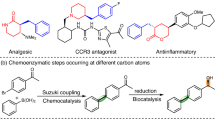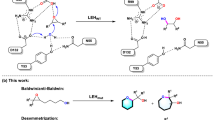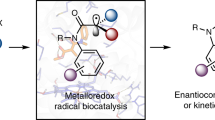Abstract
Reductive desymmetrization of 2,2-disubstituted prochiral 1,3-cyclodiketones to 2,2-disubstituted-3-hydroxycycloketones is a highly desired transformation for the construction of complex molecules with multiple chiral centres, but the generation of a single stereoisomer is difficult and an extremely challenging task in organic chemistry. In this study, by using ethyl secodione as the model substrate and an engineered carbonyl reductase from Ralstonia sp. as the biocatalyst, we realized the efficient reductive desymmetrization of 2,2-disubstituted cyclodiketones to give essentially one single stereoisomer. The mutant enzyme F12 (I91V/I187S/I188L/Q191N/F205A) showed an 183-fold enhancement of enzyme activity and outstanding stereoselectivity towards most of the tested prochiral 1,3-cyclodiketones. Crystal structural analysis and molecular dynamics studies reveal the molecular basis for activity improvement and the stereoselectivity control mechanism. Our results show that by altering the active site conformation populations (particularly the position of an α-helix) to properly accommodate the larger substrate and co-factor for catalysis, this challenging synthetic problem can ultimately be addressed.
This is a preview of subscription content, access via your institution
Access options
Access Nature and 54 other Nature Portfolio journals
Get Nature+, our best-value online-access subscription
$29.99 / 30 days
cancel any time
Subscribe to this journal
Receive 12 digital issues and online access to articles
$119.00 per year
only $9.92 per issue
Buy this article
- Purchase on Springer Link
- Instant access to full article PDF
Prices may be subject to local taxes which are calculated during checkout





Similar content being viewed by others
References
Zeng, X. P., Cao, Z. Y., Wang, Y. H., Zhou, F. & Zhou, J. Catalytic enantioselective desymmetrization reactions to all-carbon quaternary stereocenters. Chem. Rev. 116, 7330–7396 (2016).
Bressy, C., Merad, J., Candy, M. & Pons, J.-M. Catalytic enantioselective desymmetrization of compounds in total synthesis of natural products: towards an economy of chiral reagents. Synthesis 49, 1938–1954 (2017).
Paul, C. E., Lavandera, I., Gotor-Fernández, V., Kroutil, W. & Gotor, V. Escherichia coli/ADH-A: an all-inclusive catalyst for the selective biooxidation and deracemisation of secondary alcohols. ChemCatChem 5, 3875–3881 (2013).
Díaz-Rodríguez, A., Iglesias-Fernández, J., Rovira, C. & Gotor-Fernández, V. Enantioselective preparation of δ-valerolactones with horse liver alcohol dehydrogenase. ChemCatChem 6, 977–980 (2014).
Skoupi, M., Vaxelaire, C., Strohmann, C., Christmann, M. & Niemeyer, C. M. Enantiogroup-differentiating biocatalytic reductions of prochiral Cs-symmetrical dicarbonyl compounds to meso Compounds. Chem. Eur. J. 21, 8701–8705 (2015).
Holec, C., Neufeld, K. & Pietruszka, J. P450 BM3 Monooxygenase as an efficient NAD(P)H-oxidase for regeneration of nicotinamide cofactors in ADH-catalysed preparative scale biotransformations. Adv. Synth. Catal. 358, 1810–1819 (2016).
Applegate, G. A. & Berkowitz, D. B. Exploiting enzymatic dynamic reductive kinetic resolution (DYRKR) in stereocontrolled synthesis. Adv. Synth. Catal. 357, 1619–1632 (2015).
Friest, J. A., Maezato, Y. & Berkowitz, D. B. Use of a robust dehydrogenase from an archael hyperthermophile in asymmetric catalysis–dynamic reductive kinetic resolution entry into (S)-profens. J. Am. Chem. Soc. 132, 5930–5931 (2010).
Yeung, Y.-Y., Chein, R.-J. & Corey, E. J. Conversion of Torgov’s synthesis of estrone into a highly enantioselective and efficient process. J. Am. Chem. Soc. 129, 10346–10347 (2007).
Yanai, M., Sugai, T. & Mori, K. Synthesis of (S)-2-hydroxy-β-ionone, employing (S)-3-hydroxy-2,2-dimethylcyclohexanone as the chiral starting material. Agric. Biol. Chem. 49, 2373–2377 (2014).
Wei, Z.-L., Li, Z.-Y. & Lin, G.-Q. Baker’s yeast mediated mono-reduction of 1,3-cyclohexanediones bearing two identical C(2) substituents. Tetrahedron: Asymmetry 12, 229–233 (2001).
Mori, K. & Mori, H. Synthesis of (1S, 5R)-Karahana ether and (1S, 5R)-Karahana lactone. The optical active forms of unique monoterpenen with a 6-Oxabicyclo[3,2,1]octane ring system. Tetrahedron 41, 5487–5493 (1985).
Ananchenko, S. N., Limanov, V. Y., Leonov, V. N., Rzheznikov, V. N. & Torgov, I. V. Synthesis of derivatives of oestrane and 19-norsteroids from 6-methoxytetralone and 6-hydroxytertralone. Tetrahedron 18, 1355–1367 (1962).
Gibian, H. et al. Totalsynthese von natürlichem üstradiolmethylather. Tetrahedron Lett. 21, 2321–2330 (1966).
Brooks, D. W., Grothaus, P. G. & Irwin, W. L. Chiral cyclopentanoid synthetic intermediates via asymmetric microbial reduction of prochiral 2,2-disubstituted cyclopentanediones. J. Org. Chem. 47, 2820–2821 (1982).
Brooks, D. W. & Woods, K. W. Chiral building blocks for fused cyclopentanoids: enantioselective synthesis of 5-methylbicyclo[3.3.0]oct-l-ene-3,6-dione and derivatives. J. Org. Chem. 52, 2036–2039 (1987).
Murai, A., Tanimoto, N., Sakamoto, N. & Masamune, T. Total synthesis of glycinoeclepin A. J. Am. Chem. Soc. 110, 1985–1986 (1988).
Thornton, P. D. & Burnell, D. J. A Pauson–Khand and ring-expansion approach to the aquariane ring system. Org. Lett. 8, 3195–3198 (2006).
Chapelon, A.-S., Moraléda, D., Rodriguez, R., Ollivier, C. & Santelli, M. Enantioselective synthesis of steroids. Tetrahedron 63, 11511–11616 (2007).
Breitler, S. & Carreira, E. M. Total synthesis of (+)-crotogoudin. Angew. Chem. Int. Ed. Engl. 52, 11168–11171 (2013).
Contente, M. L., Molinari, F., Serra, I., Pinto, A. & Romano, D. Stereoselective enzymatic reduction of ethyl secodione: preparation of a key intermediate for the total synthesis of steroids. Eur. J. Org. Chem. 2016, 1260–1263 (2016).
Butler, B., Schultz, T. & Simpkins, N. S. Chiral base mediated transformation of cyclic 1,3-diketones. Chem. Commun. 2006, 3634–3636 (2006).
Kosmol, H. et al. Mikrobiologische stereospezifische Reduktion von 3-Methoxy-8.14-seco-l.3.5(10) 9-ostratetraen-14.17-dion. Liebigs Ann. Chem. 701, 199–205 (1967).
Brooks, D. W., Mazdiyasni, H. & Chakrabarti, S. Chiral cyclohexanoid synthesis precursors via asymmetric microbial reduction of prochiral cyclohexandiones. Tetrahedron Lett. 25, 1241–1244 (1984).
Brooks, D. W., Mazdiyashi, H. & Sally, P. Microbial reduction of prochiral 2,2-disubstituted 1,3-cycloheptanediones. J. Org. Chem. 50, 3411–3414 (1985).
Brooks, D. W., Mazdiyasni, H. & Grothaust, P. G. Asymmetric microbial reduction of prochiral 2,2-disubstituted cycloalkanediones. J. Org. Chem. 52, 3232–3239 (1987).
Zhou, W.-S., Huang, D.-Z., Dong, Q.-C. & Wang, Z.-Q. Asymmetrical reduction of the symmetrical diketongs by micro-organism. Acta Chim. Sin. 40, 648–656 (1982).
Dall′Oglio, F. et al. Flow-based stereoselective reduction of ketones using an immobilized ketoreductase/glucose dehydrogenasemixed bed system. Catal. Commun. 93, 29–32 (2017).
Ema, T., Yagasaki, H., Okita, N., Takeda, M. & Sakai, T. Asymmetric reduction of ketones using recombinant E. coli cells that produce a versatile carbonyl reductase with high enantioselectivity and broad substrate specificity. Tetrahedron 62, 6143–6149 (2006).
Peretz, M. et al. Molecular cloning, nucleotide sequecing, and expression of genes encoding alcohol dehydrogenase from the thermophile Thermoanaerobacter brockii and the meso phile Clostridium beijerinckii. Anaerobe 3, 259–270 (1997).
Lavandera, I. et al. Stereoselective bioreduction of bulky-bulky ketones by a novel ADH from Ralstonia sp. J. Org. Chem. 73, 6003–6005 (2008).
Cuetos, A. et al. Access to enantiopure α-alkyl-β-hydroxy esters through dynamic kinetic resolutions employing purified/overexpressed alcohol dehydrogenases. Adv. Synth. Catal. 354, 1743–1749 (2012).
Kulig, J. et al. Stereoselective synthesis of bulky 1,2-diols with alcohol dehydrogenases. Catal. Sci. Technol. 2, 1580–1589 (2012).
Lerchner, A., Jarasch, A., Meining, W., Schiefner, A. & Skerra, A. Crystallographic analysis and structure-guided engineering of NADPH-dependent Ralstonia sp. alcohol dehydrogenase toward NADH cosubstrate specificity. Biotechnol. Bioeng. 110, 2803–2814 (2013).
Man, H. et al. Structures of alcohol dehydrogenases from Ralstonia and Sphingobium spp. Reveal the molecular basis for their recognition of ‘Bulky–Bulky’ ketones. Top. Catal. 57, 356–365 (2014).
Durrant, J. D., Votapka, L., Sørensen, J. & Amaro, R. E. POVME 2.0: an enhanced tool for determining pocket shape and volume characteristics. J. Chem. Theory Comput. 10, 5047–5056 (2014).
Trott, O. & Olson, A. J. Software news and update autoDock vina: improving the speed and accuracy of docking with a new scoring function, efficient optimization, and multithreading. J. Comput. Chem. 31, 455–461 (2010).
Maria-Solano, M. A., Romero-Rivera, A. & Osuna, S. Exploring the reversal of enantioselectivity on a zinc-dependent alcohol dehydrogenase. Org. Biomol. Chem. 15, 4122–4129 (2017).
Li, G., Maria-Solano, M. A., Romero-Rivera, A., Osuna, S. & Reetz, M. Inducing high activity of a thermophilic enzyme at ambient temperatures by directed evolution. Chem. Commun. 53, 9454–9457 (2017).
Maria-Solano, M. A., Serrano-Hervás, E., Romero-Rivera, A., Iglesias-Fernández, J. & Osuna, S. Role of conformational dynamics in the evolution of novel enzyme function. Chem. Commun. 54, 6622–6634 (2018).
Takhashi, H., Ishida-Yamanoto, A. & Iizuka, H. Effects of bepotastine, cetirizine, fexofenadine, and olopatadine on histamine-induced wheal-and flare-response, sedation, and psychomotor performance. Clin. Exp. Dermatol. 29, 526–532 (2004).
Gora, A., Brezovsky, J. & Damborsky, J. Gates of enzymes. Chem. Rev. 113, 5871–5923 (2013).
Kreß, N., Halder, J. M., Rapp, L. R. & Hauer, B. Unlocked potential of dynamic elements in protein structures: channels and loops. Curr. Opin. Chem. Biol. 47, 109–116 (2018).
Davey, J. A., Damry, A. M., Goto, N. K. & Chica, R. A. Rational design of proteins that exchange on functional timescales. Nat. Chem. Biol. 13, 1280–1285 (2017).
Romero-Rivera, A., Garcia-Borràs, M. & Osuna, S. Role of conformational dynamics in the evolution of retro-aldolase activity. ACS catal. 7, 8524–8532 (2017).
Zhu, D., Malik, H. T. & Hua, L. Asymmetric ketone reduction by a hyperthermophilic alcohol dehydrogenase. The substrate specificity, enantioselectivity and tolerance of organic solvents. Tetrahedron: Asymmetry 17, 3010–3014 (2006).
Kaluzna, I. A., Matsuda, T., Sewell, A. K. & Stewart, J. D. Systematic investigation of Saccharomyces cerevisiae enzymes catalyzing carbonyl reductions. J. Am. Chem. Soc. 126, 12827–12832 (2004).
Liang, J. et al. Ketoreductase polypeptides and uses thereof. US patent no. WO2009042984A1 (2009).
Edegger, K. et al. Biocatalytic deuterium- and hydrogen-transfer using over-expressed ADH-‘A’: enhanced stereoselectivity and 2H-labeled chiral alcohols. Chem. Commun. 2006, 2402–2404 (2006).
Kita, K. et al. Cloning, overexpression, and mutagenesis of the Sporobolomyces salmonicolor Aku4429 gene encoding a new aldehyde reductase, which catalyzes the stereoselective reduction of ethyl 4-chloro-3-oxobutanoate to ethyl (S)-4-chloro-3-hydroxybutanoate. Appl. Environ. Microbiol. 65, 5207–5211 (1999).
Lampel, K. A., Uratani, B., Chaudhry, G. R., Ramaley, R. F. & Rudikoff, S. Characterization of the developmentally regulated Bacillus subtilis gluocose dehydrogenase gene. J. Bacteriol. 166, 238–243 (1986).
Braga, A. L., Paixão, M. W., Westermann, B., Schneider, P. H. & Wessjohann, L. A. Acceleration of arylzinc formation and its enantioselective addition to aldehydes by microwave irradiation and aziridine-2-methanol catalysts. J. Org. Chem. 73, 2879–2882 (2008).
Yang, Y.-X. et al. Aryl bromides as inexpensive starting materials in the catalytic enantioselective arylation of aryl aldehydes: the additive TMEDA enhances the enantioselectivity. J. Org. Chem. 79, 10696–10702 (2014).
Discovery Studio V4.1 (Dassault Systèmes BIOVIA).
The PyMOL Molecular Graphics System, Version v1.8.2.3 (Schrödinger LLC).
Case, D. A. et al. AMBER v.16 (University of California, San Francisco, 2016).
Wang, J., Wolf, R. M., Caldwell, J. W., Kollman, P. A. & Case, D. A. Development and testing of a general amber force field. J. Comput. Chem. 25, 1157–1174 (2004).
Bayly, C. I., Cieplak, P., Cornell, W. & Kollman, P. A. A well-behaved electrostatic potential based method using charge restraints for deriving atomic charges: the RESP model. J. Phys. Chem. 97, 10269–10280 (1993).
Singh, U. C. & Kollman, P. A. An approach to computing electrostatic charges for molecules. J. Comput. Chem. 5, 129–145 (1984).
Besler, B. H., Merz, K. M. & Kollman, P. A. Atomic charges derived from semiempirical methods. J. Comput. Chem. 11, 431–439 (1990).
Frisch, M. J. et al. Gaussian 09, Revision A.02 (Gaussian, 2009).
Anandakrishnan, R., Aguilar, B. & Onufriev, A. V. H++ 3.0: automating pK prediction and the preparation of biomolecular structures for atomistic molecular modeling and simulations. Nucleic Acids Res. 40, W537–W541 (2012).
Ryde, U. On the role of Glu-68 in alcohol dehydrogenase. Protein Sci. 4, 1124–1132 (1995).
Ryde, U. Molecular dynamics simulations of alcohol dehydrogenase with a four- or five-coordinate catalytic zinc ion. Proteins 21, 40–56 (1995).
Jorgensen, W. L., Chandrasekhar, J., Madura, J. D., Impey, R. W. & Klein, M. L. Comparison of simple potential functions for simulating liquid water. J. Chem. Phys. 79, 926–935 (1983).
Hornak, V. et al. Comparison of multiple Amber force fields and development of improved protein backbone parameters. Proteins 65, 712–725 (2006).
Darden, T., York, D. & Pedersen, L. Particle mesh Ewald: an N⋅log(N) method for Ewald sums in large systems. J. Chem. Phys. 98, 10089–10092 (1993).
Acknowledgements
We would like to thank L. Pu of the Department of Chemistry, University of Virginia for the helpful discussions about the chirality of the products. This work was financially supported by the National Key R&D Program of China (no. 2018YFA0901600), National Natural Science Foundation of China (no. 21602246) and Tianjin Municipal Science and Technology Commission (nos 15PTGCCX00060 and 15PTCYSY00020). M.A.M.S. is grateful to the Spanish MINECO for a PhD fellowship (BES-2015-074964). S.O. thanks the funding from the European Research Council (ERC) under the European Union’s Horizon 2020 research and innovation program (ERC-2015-StG-679001) and the Spanish MINECO for I+D project PGC2018-102192-B-I00. M.A.M.S. and S.O. thank the Generalitat de Catalunya for the group-emergent CompBioLab (2017 SGR-1707).
Author information
Authors and Affiliations
Contributions
X.C., H.Z., Q.W., Y.M. and D.Z. conceived and designed the project. X.C. synthesized the compounds, purified the products and analysed the chirality of all of the products. H.Z. designed and performed the mutation, screening and growing crystal experiments. M.A.M.-S. performed the molecular dynamics simulations. J.L. performed the HPLC analyses. W.L. and R.-T.G. collected crystallographic data and solved all of the structures. J.F. carried the docking experiments. X.L. optimized the fermentation conditions. X.C., H.Z., M.A.M.-S., S.O., Q.W. and D.Z. wrote the manuscript. S.O., Q.W., Y.M and D.Z. directed the project.
Corresponding authors
Ethics declarations
Competing interests
The authors declare no competing interests.
Additional information
Publisher’s note Springer Nature remains neutral with regard to jurisdictional claims in published maps and institutional affiliations.
Supplementary information
Supplementary Information
Supplementary Methods, Tables 1–4, Figs. 1–28 and References
Supplementary Data 1
Initial_structure_MD_F12-C_1a-13R17S
Supplementary Data 2
Initial_structure_MD_F12-C_3k-2R3S
Supplementary Data 3
Initial_structure_MD_F12-C_3k-2S3R
Supplementary Data 4
Initial_structure_MD_F12-D_1a-13R17R
Supplementary Data 5
Initial_structure_MD_WT
Supplementary Data 6
Initial_structure_MD_WT-E_1a-13R17R
Supplementary Data 7
Initial_structure_MD_WT-E_1a-13R17S
Supplementary Data 8
Initial_structure_MD_WT-E_1a-13S17R
Supplementary Data 9
Initial_structure_MD_WT-E_1a-13S17S
Supplementary Data 10
Initial_structute_MD_F12
Supplementary Data 11
Substrate_1a_QM
Supplementary Data 12
Substrate_3k_QM
Rights and permissions
About this article
Cite this article
Chen, X., Zhang, H., Maria-Solano, M.A. et al. Efficient reductive desymmetrization of bulky 1,3-cyclodiketones enabled by structure-guided directed evolution of a carbonyl reductase. Nat Catal 2, 931–941 (2019). https://doi.org/10.1038/s41929-019-0347-y
Received:
Accepted:
Published:
Issue Date:
DOI: https://doi.org/10.1038/s41929-019-0347-y
This article is cited by
-
Engineered enzymes for the synthesis of pharmaceuticals and other high-value products
Nature Synthesis (2024)
-
Catalytic desymmetrization reactions to synthesize all-carbon quaternary stereocentres
Nature Synthesis (2023)
-
Structural analysis of an anthrol reductase inspires enantioselective synthesis of enantiopure hydroxycycloketones and β-halohydrins
Nature Communications (2023)
-
Biocatalytic characterization of an alcohol dehydrogenase variant deduced from Lactobacillus kefir in asymmetric hydrogen transfer
Communications Chemistry (2023)
-
A multi-enzyme cascade for efficient production of d-p-hydroxyphenylglycine from l-tyrosine
Bioresources and Bioprocessing (2021)



